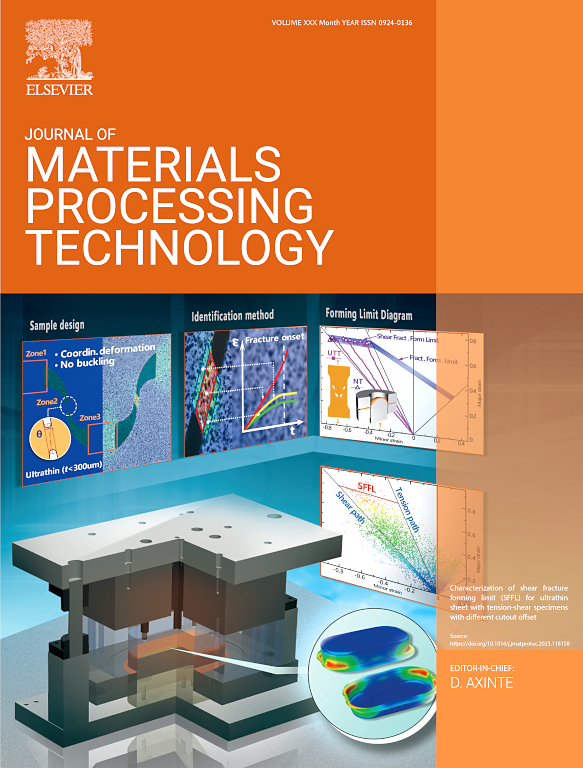铝/钢电阻点焊超声振动的超声电极设计及时空配置策略
IF 6.7
2区 材料科学
Q1 ENGINEERING, INDUSTRIAL
Journal of Materials Processing Technology
Pub Date : 2025-05-12
DOI:10.1016/j.jmatprotec.2025.118897
引用次数: 0
摘要
探索超声纵向振动辅助电阻点焊的合理有效的超声振动时空构型策略,对于制造高强度、高可靠性的铝/钢焊接接头具有重要意义。然而,系统的声电极设计方法、空间结构(电极-声电极几何耦合、振动应用位置)和时间结构(振动持续时间)在相关工作中被严重忽视。本文提出了一种系统的UA-RSW工艺声呐电极设计方法,实现了超声激励系统与声呐电极的频率匹配。系统研究了超声振动施加位置和电极-声电极组合对铝/钢UA-RSW接头宏观形貌和力学性能的影响。实验结果表明,将超声振动指向钢板可以提高能量传递效率,从而提高钢板的熔化速度和导热系数,最终增加铝核直径。进一步的研究表明,采用截短半径的电极-声电极组合促进了径向焦耳传热,抑制了铝合金板的厚度减小,平均抗拉剪切强度为6.14 kN。超声时间策略研究表明,将超声振动时间从350 ms延长至550 ms,可有效促进铝熔化区和热影响区晶粒细化,铝熔化区中心区域的平均晶粒尺寸减小54.3% %。此外,超声振动对铝合金凝固后接头组织的调节作用明显减弱。实验结果表明,去除电流后延迟100 ms的超声振动可以有效地平衡IMC层的生长和晶粒分布。这些系统的研究可以为铝/钢UA-RSW在汽车中的应用提供理论指导和实践方法。本文章由计算机程序翻译,如有差异,请以英文原文为准。
Sonotrode design and spatial-temporal configuration strategy of ultrasonic vibration for aluminum/steel resistance spot welding
Exploring the rational and effective spatial-temporal configuration strategy of ultrasonic vibration for the ultrasonic longitudinal vibration-assisted resistance spot welding (UA-RSW) is significant important for the manufacture of high-strength and reliable aluminum/steel welded joints. However, systematic sonotrode design methods, spatial configurations (electrode-sonotrode geometric coupling, vibration application position), and temporal configuration (vibration duration) have been severely neglected in related work. This work proposes a systematic method for sonotrode design in UA-RSW process, achieving frequency matching between the ultrasonic excitation system and sonotrode. The effects of ultrasonic vibration application position and electrode-sonotrode combination on the macro-morphology and mechanical performance of aluminum/steel UA-RSW joints were systematically investigated. Experimental results revealed that directing ultrasonic vibrations toward the steel sheet increased energy transfer efficiency, which enhances sheet melting rate and thermal conductivity, ultimately increasing aluminum nugget diameters. Further studies demonstrated that the application of a radius-truncated electrode-sonotrode combination promoted radial Joule heat transfer and inhibited thickness reduction of the aluminum alloy sheet, achieving an average tensile-shear strength of 6.14 kN. The study on ultrasonic temporal strategy revealed that extending ultrasonic vibration duration from 350 ms to 550 ms effectively promoted grain refinement in both the aluminum melting zone and the heat-affected zone with the average grain size at the center region of the aluminum melting zone reduced by 54.3 %. Additionally, the regulation effect of ultrasonic vibration on the joint microstructure was significantly diminished after the solidification of the aluminum alloy. The experimental results demonstrated that ultrasonic vibration delayed by 100 ms post-current removal can effectively balance the IMC layer growth and grain distribution. These systematic investigations can provide both theoretical guidance and practical methodology for aluminum/steel UA-RSW in automotive applications.
求助全文
通过发布文献求助,成功后即可免费获取论文全文。
去求助
来源期刊

Journal of Materials Processing Technology
工程技术-材料科学:综合
CiteScore
12.60
自引率
4.80%
发文量
403
审稿时长
29 days
期刊介绍:
The Journal of Materials Processing Technology covers the processing techniques used in manufacturing components from metals and other materials. The journal aims to publish full research papers of original, significant and rigorous work and so to contribute to increased production efficiency and improved component performance.
Areas of interest to the journal include:
• Casting, forming and machining
• Additive processing and joining technologies
• The evolution of material properties under the specific conditions met in manufacturing processes
• Surface engineering when it relates specifically to a manufacturing process
• Design and behavior of equipment and tools.
 求助内容:
求助内容: 应助结果提醒方式:
应助结果提醒方式:


